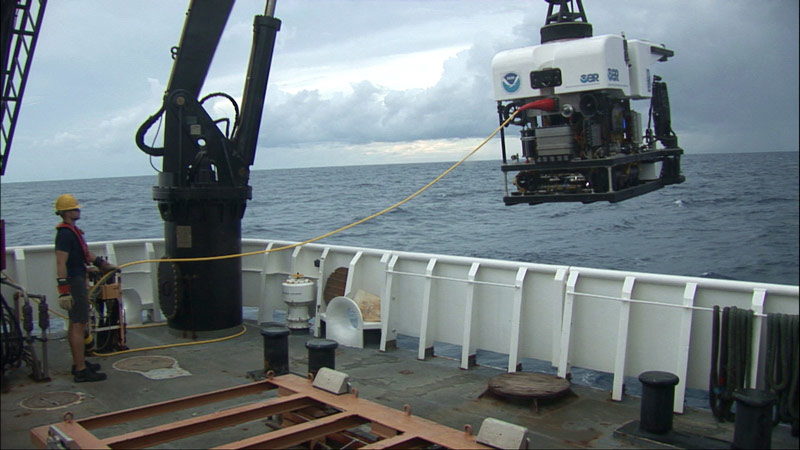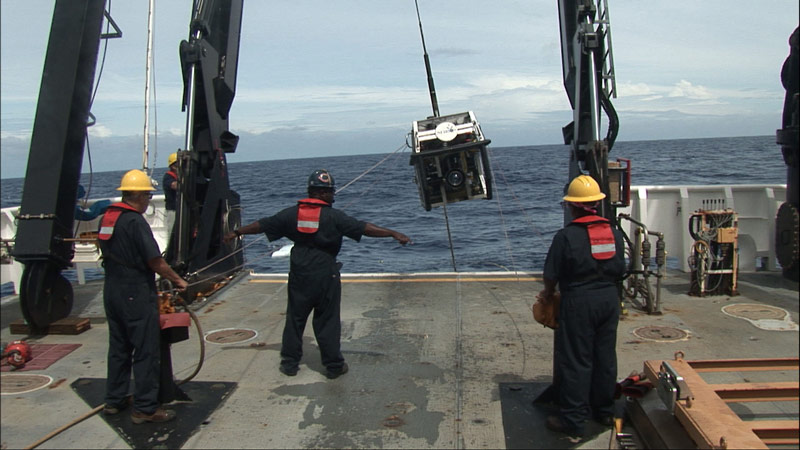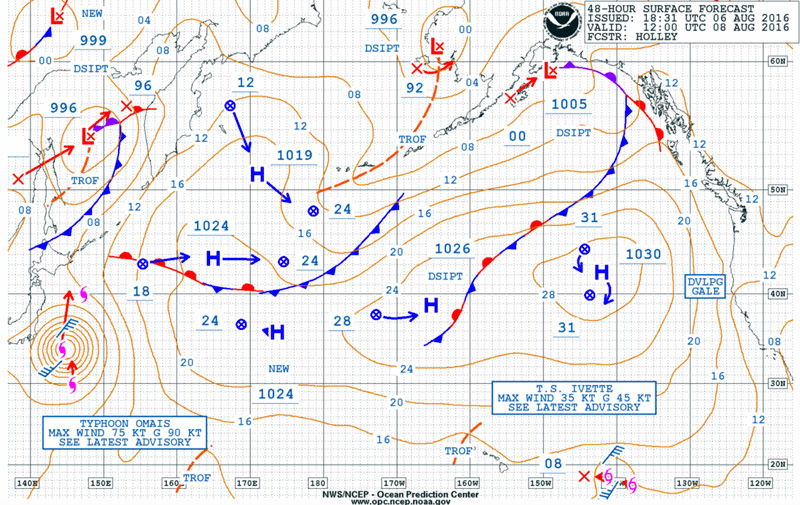
By LTJG Nick Pawlenko, NOAA Office of Ocean Exploration and Research
August 7, 2016
While the ship’s crew, scientists, and engineers can prepare for months for a given expedition, not much can be done to prepare for poor weather conditions. Sure, expedition coordinators and bridge officers can adjust schedules and plan dives around weather days, but often weather can be unpredictable. Launching a remotely operated vehicle (ROV) to depths of over 4,800 meters (three miles) in calm conditions can be challenging—adding highs seas and strong winds can further complicate a challenging dive.

ROV Engineer Chris Ritter manages the tether during recovery of Deep Discoverer. Image courtesy of the NOAA Office of Ocean Exploration and Research, Deepwater Wonders of Wake. Download larger version (jpg, 744 KB).
While at depth, the ROV might capture serene video of the deep ocean, but at the surface, it might be a very different story. ROV Deep Discoverer, also known as D2, is part of a two-body system that also includes ROV Seirios. These ROVs work together and are also tethered to the ship using .68-inch-diameter steel cable. Because they are attached to the ship, the ROVs are not immune to conditions at the sea surface. If the ship is heaving and rolling, the ROVs will feel the effects through the cable. Seirios has been designed to take the brunt of the abuse, allowing D2 to take those great shots that you see at home.

Able-bodied Seaman Abe Mcdowell instructs Able-bodied Seaman Nicky Applewhite and General Vessel Assistant Frank Polonak during launch of ROV Seirios. Image courtesy of the NOAA Office of Ocean Exploration and Research, Deepwater Wonders of Wake. Download larger version (jpg, 666 KB).
Launching the ROVs is a well choreographed evolution that takes coordination from all parties onboard. The deck crew, often operating less than a foot from the water’s edge, are handling tethers and lines for ROVs that weigh up to 9,000 pounds – all while on a rolling and pitching ship.
When deciding conditions for launch, safety is always paramount. The bridge officers, bosun, expedition coordinator, and ROV dive supervisor all meet on the bridge early every morning to discuss launch conditions and work to find the best ride for a safe launch.
NOAA Ship Okeanos Explorer is equipped with a Dynamic Positioning System (DP). This system controls all of the ship’s props, rudders, and thrusters when engaged. The DP system is important because it can keep the ship locked in one position, allowing operators to make very precise ship moves. These ship moves are translated down the cable that attaches the ROVs to the ship, moving the ROVs across the ocean floor at depths of up to 6,000 meters (3.7 miles).
Strong weather can affect DP operations and limit the ship’s ability to hold a position. If the ship is pushed off of a location due to weather, the ROVs are also pushed. This can be very dangerous when operating near an underwater rock wall.

The 48-hour weather prediction from the National Weather Service/National Centers for Environmental Prediction, Ocean Prediction Center. Image courtesy of the Ocean Prediction Center. Download larger version (jpg, 2.3 MB).
The expedition coordinator and ROV dive supervisor work with ship’s personnel, closely looking at weather before every dive. These reports are provided by NOAA and the ship also receives personalized weather predictions from the Navy based on the ship’s precise location and destination. These reports are also viewed with weather observations logged on the ship with barometric pressure, wind, and waves.
It is important to note that if conditions deteriorate, it may take over two hours to recover the ROVs from depths greater than 2,800 meters (three miles) below the water’s surface.
All of these factors are reviewed before a final decision is made and all groups give a green light to dive. If not all groups give the go ahead to dive, the dive is either postponed or cancelled.
Currently, we cancelled today’s dive, heading south to avoid weather conditions near Wake Island. Hopefully, conditions will improve and we will dive tomorrow.
“Weather forecast for tonight: dark.” —George Carlin
“Waves are not measured in feet or inches, they are measured in increments of fear.” —Buzzy Trent
“The trouble with weather forecasting is that it’s right too often for us to ignore it and wrong too often for us to rely on it.” —Patrick Young
“I hate storms, but calms undermine my spirits.” —Bernard Moitessier